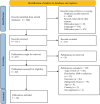Household dysfunction and child outcomes in the Nordic countries: A bibliometric analysis
- PMID: 40413610
- PMCID: PMC12374006
- DOI: 10.1177/14034948251336851
Household dysfunction and child outcomes in the Nordic countries: A bibliometric analysis
Abstract
Aims: This article provides a bibliometric analysis of the literature on adverse childhood experiences (ACEs) related to household dysfunction (parents' substance abuse, physical or mental illness, death, criminality, and divorce/separation) in five Nordic countries. We identify: 1) main patterns and characteristics of the literature on household dysfunction ACEs and child outcomes; 2) highlight research gaps, topics and approaches for future inquiry on these ACEs.
Methods: A systematic search for peer-reviewed articles published from 1998 to 2022 in English was conducted in seven databases. Information from the articles was extracted using a coding matrix that included variables related to country, specific household dysfunction ACE(s) occurring before 18 years, child outcome(s), method, data source(s) and whether resilience or protective factors were assessed. Bibliometric analyses were used to summarize the literature patterns.
Results: A total of N=5003 publications were identified and n=342 publications were included in the analysis. n=112 publications studied two or more ACEs of interest. Divorce/separation was the most common individual ACE (n=97), whereas parental criminality was the least common (n=9). n=197 publications studied child mental health outcomes, whereas educational (n=41) and labour market (n=11) outcomes were less represented. Few (n=36) studies included protective factors.
Conclusions: Our findings suggest a notable increase in research on household dysfunction adversities in the Nordic countries over the past two decades, focusing mainly on health-related outcomes. Future research should investigate less represented adversities, functional outcomes and protective factors. Interdisciplinary and new methodological approaches can provide fresh insights into this public health challenge.
Keywords: Adverse childhood experiences; household dysfunction; incarceration; labour market; mental health; parents; resilience; school completion; somatic health.
Conflict of interest statement
The authors have no conflicts of interest to declare.
Figures



References
-
- Felitti VJ, Anda RF, Nordenberg D, et al. Relationship of childhood abuse and household dysfunction to many of the leading causes of death in adults: The Adverse Childhood Experiences (ACE) study. Am J Prev Med 1998;14:245-58. - PubMed
-
- Hughes K, Bellis MA, Hardcastle KA, et al. The effect of multiple adverse childhood experiences on health: A systematic review and meta-analysis. Lancet Public Health 2017;2:e356-66. - PubMed
-
- Lund JI, Toombs E, Radford A, et al. Adverse childhood experiences and executive function difficulties in children: A systematic review. Child Abuse Negl 2020;106:104485. - PubMed
Publication types
LinkOut - more resources
Full Text Sources
Miscellaneous

